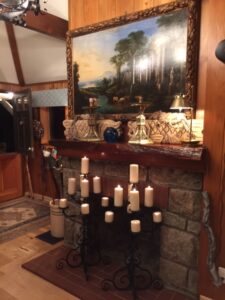 CG owns a pair of gorgeous tall, three-foot candelabras. She kept them for thirty years on her back porch on an old stone garden table in Santa Barbara. I saw these WROUGHT IRON beauties from the 1930’s in bad shape when I came to the house. I said, “restore those! They’re period pieces with a heritage in Santa Barbara.”
CG owns a pair of gorgeous tall, three-foot candelabras. She kept them for thirty years on her back porch on an old stone garden table in Santa Barbara. I saw these WROUGHT IRON beauties from the 1930’s in bad shape when I came to the house. I said, “restore those! They’re period pieces with a heritage in Santa Barbara.”
She asked, “How does wrought iron differ from cast iron, and how do I tell, and what about the valuation difference?”
Yes, a valuation difference factors in. Later we’ll discuss knock offs of her candelabras in aluminum. Also she wondered if she owns ‘appropriate’ garden furniture. She worried that her George Washington Smith home might be ‘sullied’ by mid-20th century aluminum garden furniture.
Difference between cast, wrought iron, and aluminum
How do these three mediums figure in the antique world? How do they figure into your lawn furniture, antique bed frames, and even stair railings. Santa Barbara became the center-most mecca for Spanish Colonial in the 1920-1940s, so these questions matters to us.
The photos CG sent don’t include the wonderful balustrades of her 1930s era grand Santa Barbara stairway. A reason exists for this balustrade. Wrought iron is VERY strong, and stronger than cast iron. Wrought iron means metalworkers wrought the iron. Each time they worked, heated and pounded it in shape; it became stronger.
Iron indeed the most common element on this planet, consisting of thirty-five percent of the Earth’s total mass. Only followed in prevalence by oxygen at thirty percent and silicon at fifteen percent. We find Iron in the Earth’s inner core and outer core.
Not the Same
In antique furniture we see two main forms of iron. Cast iron includes an alloy of two to four percent carbon, with silicon and manganese. Plus cast iron is made through casting, meaning it is poured into molds. Wrought iron is made of iron mixed with the by-product of the smelting: read, “pig iron.” Then those experienced metalworkers bend it and hammer it and heat it about six times, each process.
Choose wrought iron as the medium when you need something flexible and strong at the same time, like CG’s candelabras, the stair balustrade as well.
We see it in the early 20th century, its heyday, because that became the era of Revivalism with a capital “R.” Spanish Revival for example, and people, especially us in Santa Barbara, KNOW it in our vintage homes in terms of lighting fixtures, stair railings, outdoor furniture, always a best seller here in our town, and period stairs and architectural salvage.
When you look for it, generally considered more valuable that CAST, look to see mold lines, because that gives the piece away as Cast. Wrought iron, because it’s hammered repeatedly, will NOT have mold lines. CG asked if pieces bear a signature or label. Generally they’re NOT, and we must rely on the style to tell us the maker and era.
Knock offs antiques
We often see these knock offs made of aluminum in the later 20th century. All you need to distinguish wrought iron from aluminum is to PICK IT UP. Wrought feels so much heavier.
Also, aluminum doesn’t rust, and it does. Test it with a magnet and if your magnet adheres, it’s iron. If not, it’s aluminum.
The Art Deco period, 1920-1930s, became the era of wrought iron where you found great wrought iron like CG’s candelabra. The value of the pair? $1,200, and the interesting thing is that many places in the US don’t value 1930’s wrought iron the way we do in the mecca of Spanish Colonial Revival homes. And so, YOUR market, CG, if you sell, is HERE.
There you go again – teaching me about wrought iron. A medium I have always liked. I got a few pieces at the closing if Craviotto Iron Works.
But it was this paragraph that really caught my attention. You always amaze with interesting facts.
“Iron indeed the most common element on this planet, consisting of thirty-five percent of the Earth’s total mass. Only followed in prevalence by oxygen at thirty percent and silicon at fifteen percent. We find Iron in the Earth’s inner core and outer core.”
Thx